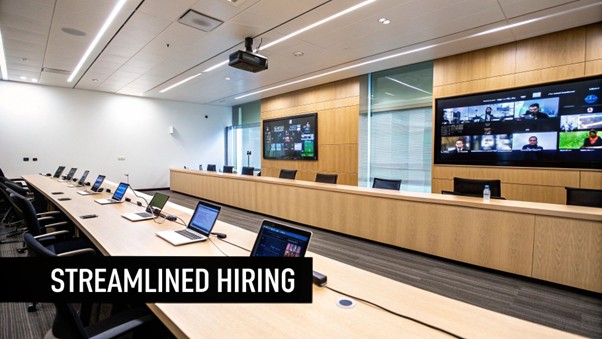Beyond Cost-Cutting: The Strategic Edge of Recruitment Outsourcing

Many see recruitment outsourcing as primarily a cost-saving measure. However, its real strength lies in offering a strategic advantage. Progressive organizations in India are now using recruitment outsourcing to enhance their competitive position. This goes beyond simply filling open roles and embraces a more complete approach to talent acquisition.
This shift recognizes the crucial role talent plays in long-term success.
Understanding Recruitment Process Outsourcing (RPO)
A vital part of strategic recruitment outsourcing is understanding the key differences between traditional staffing and Recruitment Process Outsourcing (RPO). Traditional staffing aims to fill immediate openings with temporary or contract workers.
RPO, however, provides a broader solution. It involves working with an external provider to manage part, or all, of the hiring process. This includes everything from sourcing and screening candidates to onboarding new hires.
This partnership means RPO providers collaborate closely with organizations to understand their specific needs and build tailored talent acquisition strategies.
The Growth of RPO in India
Mirroring global trends, India’s RPO market is booming. Many Indian organizations are outsourcing their entire recruitment process, typically excluding CXO-level hires. The market is projected to spend about Rs 450 crore on RPO services, within the larger Rs 7,000 crore permanent staffing market.
This highlights the growing dependence on specialized expertise for finding talent. For more insights, see: How can Recruitment Process Outsourcing help in high-impact hiring driven by data?. The efficiency and cost benefits of RPO are key drivers, freeing businesses to concentrate on their core operations. More detailed statistics can be found here: IJRAR Research Paper
Strategic Benefits of RPO
RPO enables businesses to focus on their core strengths, improve the quality of their hires, and rapidly scale their recruitment efforts. For instance, a fast-growing company can use RPO to quickly expand its team without significant investment in internal recruiting resources.
Moreover, RPO providers often have specialized knowledge in areas such as employer branding and candidate experience. This further strengthens an organization’s ability to attract and retain top-tier talent. This expertise makes RPO a valuable strategic resource in today’s competitive environment.
When RPO Makes Strategic Sense
There are several signs an organization might benefit from RPO. These include struggling to find qualified candidates for specialized roles, inconsistent hiring practices, and the need to shorten time-to-hire.
These issues often indicate a need for external guidance and more efficient recruitment procedures. Partnering with an RPO provider can effectively address these challenges and provide a considerable edge in the talent marketplace.
This strategic approach to RPO helps companies not only fill current vacancies but also build a strong talent pipeline for future expansion.
The Business Case for Recruitment Outsourcing That Actually Works

Moving beyond theory, let’s explore the real-world impact of recruitment process outsourcing (RPO). We’ll examine how strategic outsourcing has transformed talent acquisition across various sectors, delivering tangible results. This includes understanding how RPO tackles key hiring challenges like finding specialized talent, managing rapid growth, and adapting to evolving recruitment needs.
Quantifying the Benefits of Recruitment Outsourcing
A core aspect of the business case involves analyzing the financial impact. This means examining cost reductions, faster time-to-hire, and improvements in quality of hire – all critical metrics for leadership. Outsourcing can reduce overhead associated with in-house recruiting teams, including salaries, benefits, and technology investments.
Additionally, streamlined processes and access to larger talent pools through RPO often lead to significantly faster hiring cycles. This increased speed reduces lost productivity and facilitates quicker onboarding, directly benefiting the bottom line.
Specialized recruitment agencies frequently use advanced assessment tools and methodologies, leading to higher quality hires who contribute more effectively. The India Human Resource Outsourcing Market illustrates this growth. Valued at USD 138.56 million in 2024, it’s projected to reach USD 480.27 million by 2030, with a CAGR of 23.08%. This expansion is driven by demand from sectors like manufacturing, hospitality, and IT, as outsourcing reduces HR costs and provides access to specialized expertise. Find more detailed statistics here: India Human Resource Outsourcing Market
Tailoring Recruitment Outsourcing to Your Needs
Different organizations have unique business goals and market positions, requiring tailored RPO approaches. A one-size-fits-all solution isn’t effective. Some companies outsource their entire recruitment function, while others opt for a targeted approach focusing on specific roles or projects.
This flexibility allows alignment between outsourcing strategy and overall business objectives. A company experiencing rapid expansion might prioritize an RPO provider specializing in high-volume hiring. Conversely, an organization seeking niche technical skills might engage a boutique firm with expertise in that area.
Case Studies: Demonstrating Real-World Success
Real-world examples illustrate the advantages of RPO. Consider a tech startup struggling to find skilled developers. By partnering with a tech-focused recruitment outsourcing firm, the startup gains access to a broader candidate pool, specialized sourcing strategies, and efficient screening processes.
This allows them to fill key roles faster, enabling focus on product development and growth. Alternatively, a large corporation undertaking a major expansion can rapidly scale hiring efforts through outsourcing, ensuring adequate workforce without overextending internal resources. These examples demonstrate RPO’s practical applications and the tangible value it delivers.
Evaluating the Financial Impact
Understanding the financial implications is crucial for making informed decisions about RPO. This requires a detailed cost-benefit analysis considering both direct and indirect costs of in-house recruitment versus outsourcing.
To help illustrate this, the following table summarizes the key cost considerations:
| Cost Factor | In-house Recruitment | Recruitment Outsourcing | Potential Savings |
| Salaries & Benefits | High fixed costs for internal recruiters | Variable cost based on project or role | Significant, especially for niche or high-volume hiring |
| Infrastructure & Technology | Ongoing investment in HR systems and tools | Included in RPO provider’s fees | Can be substantial, depending on existing in-house resources |
| Training & Development | Costs associated with upskilling internal teams | Typically handled by the RPO provider | Moderate, as ongoing training is often necessary even with in-house teams |
| Time-to-Hire | Can be lengthy, especially for specialized roles | Often significantly faster due to dedicated resources and expertise | Reduces lost productivity and speeds up onboarding |
| Quality of Hire | Dependent on internal team’s expertise and resources | Potentially higher due to specialized knowledge and access to wider talent pools | Leads to improved employee performance and retention |
This table compares the costs and resources required for in-house recruitment versus RPO, helping businesses understand the financial implications of each approach. By carefully evaluating these factors, organizations can determine if RPO offers a compelling financial advantage. This analysis is critical for presenting a strong business case to leadership and securing buy-in for this strategic initiative.
Finding Your Perfect Recruitment Outsourcing Model

Not all recruitment outsourcing solutions are created equal. This section explores the different models available, guiding you toward the right fit for your organization’s unique needs. We’ll examine Recruitment Process Outsourcing (RPO), encompassing both full-service options that overhaul your entire talent acquisition function and project-based solutions for targeted hiring needs. We’ll also explore hybrid models that blend the strengths of internal teams and external support.
Types of Recruitment Outsourcing Models
We’ll delve into the ideal scenarios for each model, the implementation requirements, and the expected outcomes based on real-world case studies. This comprehensive overview will empower you to identify the recruitment outsourcing structure that best addresses your talent challenges and aligns with your company culture.
- End-to-End RPO: This model fully outsources your talent acquisition function. The RPO provider manages every aspect, from crafting job descriptions to onboarding new hires. This is a valuable solution for companies aiming to revamp their entire hiring process or those experiencing rapid growth requiring swift scaling.
- Project-Based RPO: This model concentrates on specific hiring projects. It proves particularly useful for short-term initiatives, filling specialized roles, or handling sudden increases in hiring demands. This approach allows you to tap into specialized expertise while retaining control over other recruitment activities.
- Hybrid RPO: This model merges the advantages of in-house and outsourced recruitment. Some aspects of the hiring process remain internal, while others are managed by the RPO provider. This adaptable approach gives you flexibility and continued control over critical components of your talent acquisition strategy while potentially offering cost savings for larger projects.
You might be interested in: Advantages of Having an RPO Partner to Attract Talent in 2023.
Choosing the Right Model for Your Organization
Selecting the optimal model hinges on several factors. Your company’s size, industry, hiring volume, internal resources, and specific talent requirements all play a crucial role. For instance, a large multinational corporation might find end-to-end RPO beneficial for standardizing global hiring practices.
Conversely, a small startup may prefer project-based RPO to support targeted hiring campaigns, optimizing their budget and internal team resources. Clearly defining your objectives and evaluating your internal capabilities are essential for choosing the most effective approach.
Implementation and Expected Outcomes
Each RPO model has distinct implementation needs. End-to-end RPO necessitates substantial process adjustments and close collaboration with the provider. Project-based RPO requires clearly defined project scope and deliverables. Hybrid models demand meticulous coordination between internal teams and the external provider.
Anticipated results also differ. End-to-end RPO can significantly improve time-to-hire, cost-per-hire, and quality-of-hire metrics. Project-based RPO delivers focused results for specific hiring initiatives. Hybrid models can boost efficiency while allowing your organization to maintain in-house expertise in key areas. Understanding these factors is crucial for successful implementation.
Making an Informed Decision
Selecting the right recruitment outsourcing model is a strategic decision. By carefully assessing your needs, exploring the various models, and planning implementation thoroughly, you can unlock the full potential of RPO. This translates to a more streamlined and effective talent acquisition process, directly contributing to your organization’s overall success. Consider running a pilot project before committing to a long-term contract to evaluate the provider’s performance and ensure the chosen model aligns with your specific needs.
Why Leading Organizations Choose Recruitment Outsourcing Partners

What sets exceptional recruitment outsourcing providers apart? Successful partnerships rely on key capabilities that deliver real results. These include a blend of advanced technology, refined assessment methods, and deep market understanding. These factors combine to create tangible competitive advantages for organizations that outsource their recruitment processes.
Leveraging Expertise for Enhanced Talent Acquisition
Leading organizations in India are using their outsourcing partners’ expertise to improve their talent acquisition strategies. This involves concentrating on important areas such as employer branding, enhancing the candidate experience, and focusing on diversity recruitment. A strong employer branding strategy, created in collaboration with an RPO provider, can greatly improve a company’s ability to attract top-tier candidates.
A positive candidate experience is also critical. It ensures that potential hires have a favorable impression of the organization throughout the entire hiring process. This can be a deciding factor in a competitive job market. Recruitment outsourcing partners can also help build a more diverse and inclusive workforce, bringing fresh perspectives and innovative ideas to the organization.
Gaining a Competitive Edge Through Specialized Services
Advanced recruitment technologies give outsourcing partners a distinct advantage. These technologies allow them to identify and assess candidates more efficiently. Specialized candidate assessment techniques go beyond traditional methods, offering a deeper understanding of a candidate’s skills and potential. This detailed approach leads to better-informed hiring decisions.
In-depth knowledge of the talent market also provides businesses with a significant edge. This allows them to understand current talent trends and anticipate future needs. This proactive approach helps organizations stay ahead of the curve and secure the best available talent. India remains a popular location for recruitment outsourcing, providing a large pool of talent and cost-effective solutions. To learn more, explore this resource: Why India Tops The List For Outsourcing Candidate Sourcing. In 2023, India’s IT outsourcing market reached $585.57 billion, and it’s projected to grow to $701.88 billion by 2028, demonstrating the continued strength of the outsourcing sector.
Transforming Talent Acquisition for Sustainable Hiring
Forward-thinking businesses in India are looking beyond simply filling open positions. They’re leveraging recruitment outsourcing to fundamentally change their talent strategies. This includes establishing sustainable hiring practices that go beyond immediate needs.
Partnering with recruitment outsourcing providers allows companies to develop long-term talent pipelines and build processes for ongoing talent acquisition. This strategic approach helps companies adapt to changing market demands and remain agile in a competitive environment. It allows them to build strong talent pools, reduce reliance on reactive hiring, and concentrate on developing a workforce ready to drive long-term success. This proactive approach is essential for sustained growth and maintaining a competitive edge. It enables organizations to invest in talent acquisition strategies that contribute to their long-term objectives and cultivate a workforce prepared for future challenges.
Selecting a Recruitment Outsourcing Partner That Delivers Results
Finding the right recruitment outsourcing partner is essential for a successful talent acquisition strategy. This section offers a practical framework for evaluating potential partners, moving beyond surface-level promises to a deeper understanding of their capabilities. We’ll explore key aspects like industry knowledge, technology utilization, quality assurance, and cultural fit. From crafting effective Requests for Proposals (RFPs) to conducting thorough assessments and structuring contracts, you’ll gain the tools to identify partners who deliver lasting value.
Defining Your Needs and Objectives
Before you begin evaluating potential partners, take the time to clearly define your organization’s unique needs and objectives. What specific talent acquisition challenges are you hoping to address through outsourcing? Are your primary goals focused on reducing time-to-hire, improving the quality of hires, or scaling recruitment efforts more rapidly? For instance, if finding specialized tech talent is a persistent struggle, prioritize partners with a demonstrable track record in that niche. A well-defined understanding of your goals will streamline the selection process and ensure the chosen partner can fulfill your specific requirements.
Assessing Industry Expertise and Technological Capabilities
Seek out partners with proven expertise in your specific industry. This includes a deep understanding of the talent market dynamics, particular skill requirements, and the overall competitive landscape. Equally crucial is evaluating their technology stack. Do they utilize modern Applicant Tracking Systems (ATS), AI-powered sourcing tools, or video interviewing platforms? These technological advancements can greatly improve the efficiency and effectiveness of your recruitment processes. A technologically adept partner offers a significant competitive edge in today’s talent market.
Evaluating Quality Assurance Processes and Cultural Alignment
Reliable outsourcing partners maintain robust quality assurance processes. Look for clear metrics used to track performance, regular reporting mechanisms, and a commitment to continuous improvement. Equally vital is cultural alignment. A partner whose values and work style mesh well with your organization’s will foster a more productive and collaborative relationship. This synergy is essential for long-term success and a mutually beneficial partnership.
Creating Effective RFPs and Conducting Capability Assessments
Your RFP should clearly articulate your requirements, expected outcomes, and the criteria you’ll use for evaluation. This ensures meaningful responses from potential partners and facilitates a more effective comparison. After shortlisting a select group of providers, conduct thorough capability assessments. This might involve presentations, interviews, and demonstrations of their technology and established processes. These assessments offer invaluable insights into their true strengths and potential limitations. For more insights on innovative recruitment strategies, check out our guide on Unique Recruitment Strategies to Hire Talent Effortlessly.
Structuring Contracts and Building Productive Partnerships
Once you’ve selected a partner, carefully structure the contract to clearly define roles, responsibilities, performance metrics, and payment terms. A well-defined contract protects your interests and establishes a solid framework for a successful partnership. However, the contract is just the starting point. Building a strong, collaborative relationship with your chosen recruitment outsourcing partner is crucial for maximizing the value of your investment. This involves regular communication, shared goals, and a mutual commitment to success.
Recruitment Outsourcing Provider Evaluation Framework
The following table offers a comprehensive framework for evaluating potential recruitment outsourcing partners. Use this matrix to guide your decision-making and select the partner that best aligns with your organization’s needs.
This comprehensive evaluation matrix helps organizations assess potential recruitment outsourcing partners across key performance dimensions, enabling more informed decision-making.
| Evaluation Criteria | Weight | Questions to Ask | Red Flags | Green Flags |
| Industry Expertise | 20% | What is your experience in our industry? Can you provide relevant case studies? | Lack of understanding of industry-specific skills and talent pools. | Proven track record of successful placements in similar organizations. |
| Technological Capabilities | 25% | What technologies do you use? How do they enhance the recruitment process? | Outdated systems, reliance on manual processes. | Use of advanced technologies like AI-powered sourcing and applicant tracking systems. |
| Quality Assurance | 15% | What are your quality control measures? How do you track and report on performance? | Lack of clear metrics or reporting mechanisms. | Documented quality assurance processes and a commitment to continuous improvement. |
| Cultural Fit | 15% | How would you describe your company culture? | Values and work style clash with your organization’s. | Shared values, emphasis on collaboration and communication. |
| Cost & Value | 25% | What are your pricing models? Can you demonstrate a clear return on investment? | Focus solely on price, lack of transparency in pricing structure. | Competitive pricing, clear value proposition, demonstrable ROI. |
By leveraging this framework, you can make a more informed decision and select a partner who contributes significantly to your talent acquisition goals.
Implementing Recruitment Outsourcing That Actually Works
A well-crafted recruitment outsourcing strategy requires careful implementation for true success. This section offers a practical roadmap for transitioning from traditional hiring to a partnered, outsourced model, minimizing disruptions and maximizing the value you receive. We’ll explore key implementation phases, from getting buy-in across your organization to mapping processes, integrating technology, and managing the inevitable changes effectively.
Aligning Stakeholders and Mapping Processes
Begin by aligning stakeholders. This involves clear communication with your internal teams, hiring managers, and the selected outsourcing provider. Ensure everyone understands the partnership’s goals, processes, and expected outcomes. This shared understanding promotes a smoother transition and builds a collaborative environment from the start.
Next, map your current recruitment processes. Detailed documentation provides a vital baseline for identifying areas for improvement and streamlining workflows with your new outsourcing partner. This exercise often reveals hidden inefficiencies and bottlenecks that outsourcing can directly address.
Technology Integration and Change Management
Technology integration is crucial. This involves connecting your outsourcing provider’s systems with your existing HR infrastructure, ensuring seamless data flow and efficient communication. This might include linking applicant tracking systems (ATS), onboarding platforms, or other recruitment tools.
Effective change management is also essential. Proactively address any concerns from internal teams, prepare hiring managers for new workflows, and clearly communicate the benefits of outsourcing to all stakeholders. Open communication and proactively addressing potential challenges are key to a successful transition.
Establishing Performance Metrics and Governance Structures
Establish clear performance metrics. These should align with your overall business objectives and track key indicators like time-to-hire, cost-per-hire, and quality of hire. Regularly reviewing these metrics with your outsourcing provider ensures accountability and drives continuous improvement.
Creating robust governance structures is also critical. This includes establishing clear communication protocols, defining roles and responsibilities, and scheduling regular review meetings. These structures provide the framework for managing the relationship with your provider and maintaining quality control.
Managing the Human Element
Transitioning to recruitment outsourcing impacts people, not just processes and technology. Addressing concerns from internal recruitment teams is paramount. Clearly communicate the rationale for outsourcing, emphasize the value the provider brings, and explore opportunities for collaboration between internal teams and the outsourcing partner. This collaborative approach can alleviate anxieties and foster a shared purpose.
Preparing hiring managers for new workflows is equally important. Provide training on the outsourced model, clarify communication channels, and ensure they understand their roles in the new process. This empowers them to collaborate effectively with the outsourcing provider, contributing to a seamless transition. Regular communication and feedback sessions can address any emerging challenges and maintain a positive working relationship.
Integrating Recruitment Outsourcing into Your Broader Talent Strategy
Recruitment outsourcing shouldn’t be a standalone initiative. Integrate it into your broader talent strategy to maximize its impact. Align the outsourced recruitment process with your overall talent acquisition goals, employer branding efforts, and employee value proposition. This ensures your outsourced hiring practices reinforce your broader talent strategy and contribute to your organization’s long-term objectives. For instance, if your talent strategy emphasizes diversity and inclusion, ensure your outsourcing partner understands and prioritizes these values in their recruitment efforts. This integration creates a cohesive and impactful talent acquisition strategy.
Are you ready to optimize your talent acquisition strategy and experience the advantages of recruitment outsourcing? Visit Taggd to learn how we can help you achieve your hiring goals.






